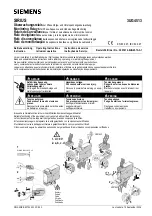
7SG11 Argus 8 Commissioning
Note : when finished testing the output relays make sure that the ‘Protection healthy’ is re-assigned to
the correct output relay given in the settings file and that all other relays have been de-selected from
this option.
Record the operation of the Output Relays in Table 2.
3.10
Voltage Input Tests
This test checks that the voltage measurements are within acceptable tolerances.
Apply rated ac volts to each of the voltage input circuits of the relay, in turn, using the ac variable
voltage source or the portable relay test set. Using a multimeter check the voltage at the relay
terminals. This should equal the voltage displayed on the relay’s secondary voltage displays, although
there is a tolerance of + 2% on the measurement display meters. If a phase VT ratio has been set, then
the primary instrument displays can be viewed. These will be scaled by the ‘Ph VT Ratio’ setting.
Relay Case Size
Voltage Input Type
Apply Voltage Between Terminals
E4
Va (Vab)
1 – 2
E4
Vo (Vbc)
3 – 4
E6
Va (Vab)
55 – 56
E6
Vb (Vbc)
53 – 54
E6
Vc (Vca)
51 – 52
Record the measured and displayed voltages in Table 3.
3.11 Applying
Settings
Wherever possible, the relay should be commissioned with the actual settings calculated for the
particular scheme. If this is not practical, however, one of the unused settings groups could be used as
a commissioning test group. For information on selecting ‘Active Settings Groups’, see Section 1 of this
manual. Note that Alarm and Tripping contacts must be programmed correctly before any scheme tests
are carried out.
Settings can be entered into the relay using the keypad on the front of the relay or they can be sent to
the relay, from a file, using a portable PC and the Reydisp Evolution software package. Entering the
settings by hand can be a slow process and therefore using a previously prepared settings file is the
recommended method. Using Reydisp Evolution also allows a hardcopy of the settings file to be easily
acquired and saved.
Once the settings have been entered they will have to be verified. This is not essential, however, if the
settings have been uploaded using Reydisp Evolution. If they have been entered by hand then the user
should step through the relay settings list and compare them with the required setting record. (Note :
see the Appendix section of this manual for Setting Configuration Sheets).
3.12 Optional
Test
It is not necessary to perform tests on all internal elements of the relay. If the settings have been
verified, the external wiring checked, the status inputs and output relays verified and the relay
measures satisfactorily then the relay can be considered to be working to its design requirements. It
will operate correctly, to the performance claims, and its operation under all service conditions is
guaranteed. For this reason it is not essential to test the operation of any of the internal relay elements.
However, if added confidence is required, then an element can be checked. Ideally an element
employed in the scheme would be the best candidate to be tested. The following example shows the
basic testing of a Voltage Element.
3.12.1 Under/Over Voltage Element
Using either the scheme settings or convenient settings, which are suitable for the limitations of
the available test equipment, energise a Voltage Element and record its pick-up and drop-off
values in Table 3. The pick-up and drop-off will be indicated by the yellow starter LED coming
on, though more detailed information is given at the starter screens in the instruments display
mode of the menu system e.g. the following display :
V Starters
VE1
©2010 Siemens Protection Devices Limited
Chapter 7 Page 7 of 12
















































